Maya Sfeir is a Lecturer based in Beirut, Lebanon. Her research interests focus on examining and understanding the literary-linguistic interface. In this blog post, she explores how sweat is represented in Victorian fiction by examining two CLiC sub-corpora, 19C and DNov. Her previous contribution to CLiC,‘On Kitchens, Keywords, Key Clusters, and Concordances…’, re-examined eating and drinking in Emily Brontë’s Wuthering Heights.
Characters in works of fiction accomplish extraordinary feats. They tame horses, fight enemies, miraculously escape from prison, and run for miles away from unwanted suitors. But the most phenomenal aspect of accomplishing all of these tasks is that characters almost never sweat (in a literal sense) while completing any form of physically demanding activity. In fact, sweat seems to be one of the most under-represented bodily functions in literary works. As Shonni Enelow (2019) remarked, ‘it is perhaps too mundane–and too easily ignored’ (p. 130) to be included in fiction. And yet, despite the fact that characters rarely seem to sweat in fiction, sweat had its own symbolic and social significance in Victorian England, the period that witnessed the heyday of the novel as a genre. In her book How to Be a Victorian, Ruth Goodman (2014) pointed out that sweat and ‘body odour took on a new dimension, one that divided the nation’ in Victorian England (p. 17). According to her, the working, middle and upper classes all smelled differently. The phrase ‘the great unwashed,’ first coined in the mid-nineteenth century to denote the working class (Goodman, 2014), continues to refer to people who lack social status.
I first came across the topic of sweat in a literature review my students had written that referenced Enelow’s (2019) aforementioned article. Skimming through Enelow’s argument, I began reflecting on the representation of sweat in fiction written during the nineteenth century, a period that witnessed a radical transformation in the nature of work as a result of the industrial revolution (see Figure 1). I thus began wondering: (1) Do characters sweat in nineteenth-century fiction, and (2) if they do, how is their sweat represented? My blog post is an attempt to answer these two questions by using the CLIC Web App developed by Mahlberg et al. (2020).
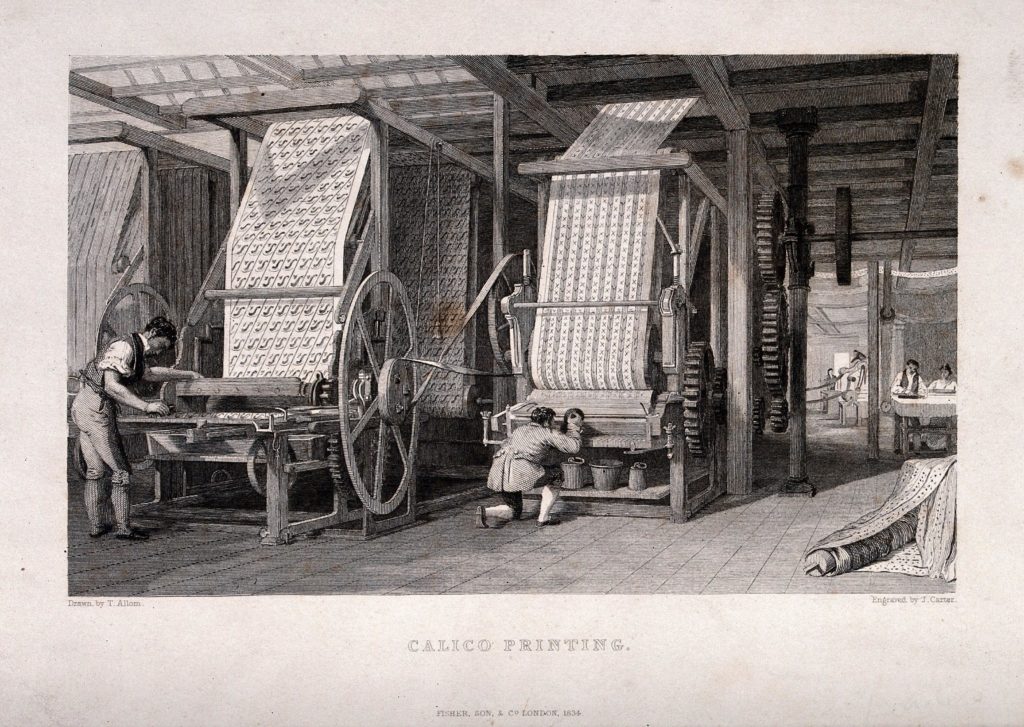
Fig. 1 Textiles: A pair of large presses for block printing calico. Engraving by J. Carter after T. Allom, 1834. Credit: Wellcome Collection. Public Domain Mark.
To answer my two questions, I decided to examine occurrences of the term sweat in its simplest form across two CLiC sub-corpora: the Nineteenth-Century Reference Corpus (19C) and Dickens’s Novels (DNov). I decided to focus on these two corpora because I anticipated Charles Dickens would have successfully captured the challenges and ‘sweating’ of the Victorian working class. 19C would in turn serve as an interesting norm to compare Dickens’s work against.
The CLiC function I chose to use is Concordance. A concordance has been defined by John Sinclair (1991) as ‘a collection of the occurrence of a word-form, each it is textual environment’ (p. 32). In other words, it is a listing of all the occurrences of a certain term as seen in its context. One of its main advantages is that it enables us to read ‘vertically, from top to bottom’ (Stubbs, 2009, p. 117) rather than horizontally, and thus depict patterns in the way a certain word occurs in context. Mahlberg and Wiegand (2018) have referred to concordances as ‘a form of linguistic visualization’ (p. 127). In CLiC, the KWICGrouper option makes it easier to detect and visualize these patterns by finding specific words within the textual context of the node word.
Do Characters Sweat in Nineteenth-Century Fiction?
The short answer is, well, yes and no. In fact, both 19C and DNov include references to sweat. Sweat occurs 17 times in 13 books in 19C and 27 times in 9 books in DNov. To better understand if there is an actual difference in the number of occurrences of the term, I decided to look at the normalized frequency, that is the frequency calculated to a common base. This method is useful when comparing corpora of different sizes, to ensure that we are not comparing apples to oranges, at least when it comes to size. The calculation is automatically provided by CLiC. Sweat has a relative frequency of 3.77 per million words in 19C and 7.04 words per million words in DNov. In other words, sweat occurs approximately twice as many times in Dickens’s novels as in 19C.
So why, then, you must be wondering, is my answer both yes and no to the question of whether characters sweat in nineteenth-century fiction. Despite the fact that sweat is mentioned in each corpus, it is mostly associated with anxiety or fear, or has a figurative dimension. Six mentions in 19C and 20 in DNov were an allusion to the Biblical verse in which God tells Adam ‘By the sweat of your brow you will eat your food until you return to the ground, since from it you were taken; for dust you are and to dust you will return’ (New International Version, 2010, Genesis 3:19). The references to sweat are thus more metaphorical than physical, an insight which brings me to my next question.
How is Sweat Represented in these Works?
A closer reading of the results reveals that in both corpora, sweat is mostly described as cold, an adjective that occurs four times in 19C and five times in DNov. The KWICGrouper option helped in highlighting the concordance lines in which the term cold occurred (see Figures 2 and 3). Characters break into cold sweats as a result of fear or anxiety. Interestingly, in both corpora, characters do not sweat from their bodies, but from their upper faces (see Figures 2 and 3). In 19C and DNov, the term sweat co-occurs with words referring to the upper face, such as forehead or brow. In 19C, concordance line 17 containing the expression ‘covered with sweat’ does not refer to a human body, but rather to that of a horse. At this point, I turned to the Biblical allusions in 19C and DNov.
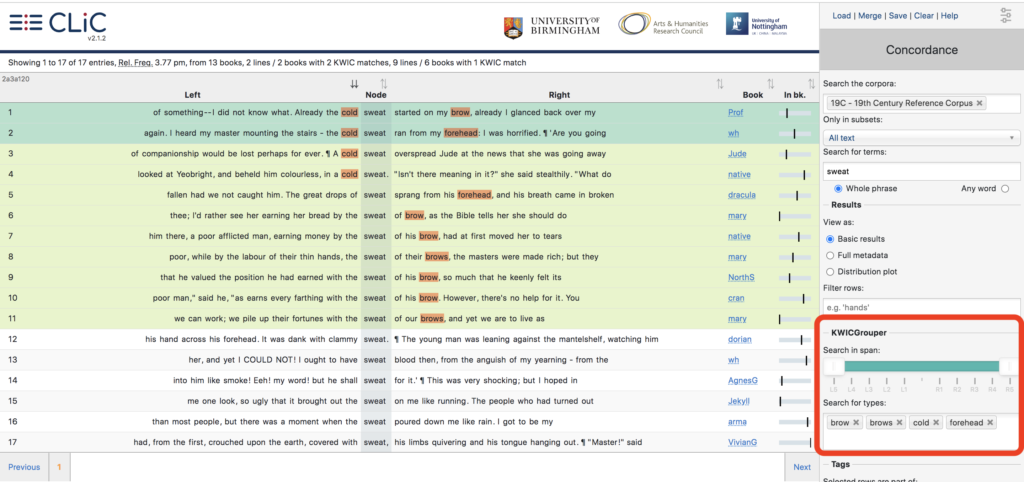
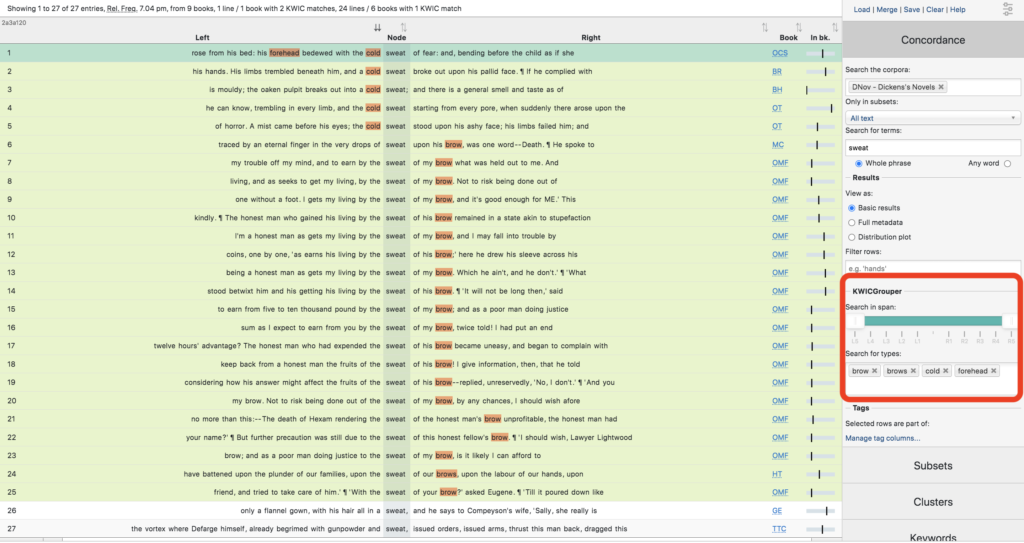
‘Sweat of Brow’ in 19C: Social and Class Inequalities in Gaskell’s Novels
Five of the six Biblical allusions in 19C occur in novels by Elizabeth Gaskell: Mary Barton (1848), Cranford (1853), and North and South (1854) that focus on social and class inequalities in nineteenth-century England. In Mary Barton, a novel that explores the challenges faced by the lower classes in Victorian cotton-manufacturing Manchester (see Figure 4), the expression ‘sweat of the brow’ reveals the deep divide that separates the upper and working classes.
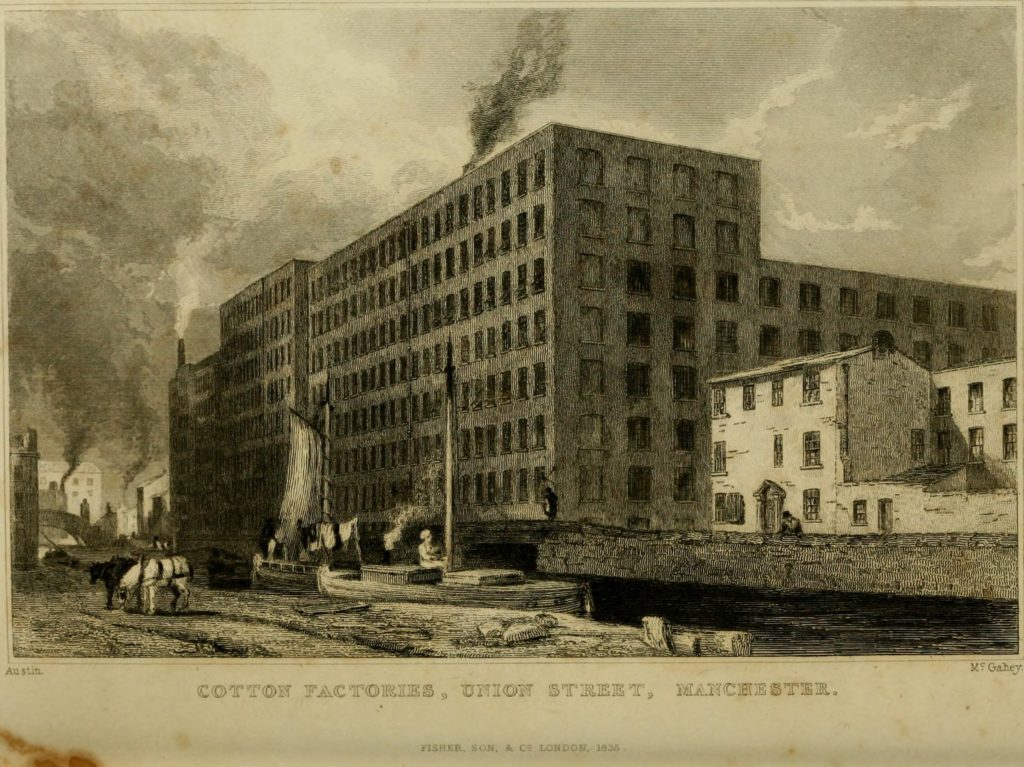
In the first occurrence of the phrase in the book, millworker and trade unionist John Barton, after complaining about ‘factory girls’ who ‘can earn so much’ and be independent, tells his fellow factory worker George Wilson that he would rather see his daughter Mary
ear[n] her bread by the sweat of brow as the Bible tells her she should do, ay, though she never got butter to her bread, than be like a do-nothing lady, worrying shopmen all morning, and screeching at her pianny all afternoon, and going to bed without having done a good turn to any one of God’s creatures but herself. [emphasis mine]
The expression, used figuratively, serves to critique the lifestyle of upper-class ladies. John Barton then comments on the inequality between the rich and poor:
We’re their slaves as long as we can work; we pile up their fortunes with the sweat of our brows, and yet we are to live as separate as if we were in two worlds; ay, as separate as Dives and Lazarus, with a great gulf betwixt us. . . . [emphasis mine]
His statement, with its particular usage of we vs. they highlights the class tensions and social struggles in Victorian England. John Barton is a member of the Chartist movement that emerged in England during the period between 1836 and 1848. Chartism sought to politically empower the working classes and to make the parliament more accessible to them (‘Chartists’, n.d.). His criticism of the upper classes thus stems from his awareness of the social and economic inequalities in Victorian British society. As such, while characters do sweat in 19C, references to sweat do not refer to the materiality of sweat; rather, they are a form of social critique.
‘Sweat of His Brow’ and Characterization in Our Mutual Friend
In DNov, 18 of the occurrences of the term sweat are found in Our Mutual Friend (1865), all of which are Biblical allusions (see Figure 5). At this point, I began wondering whether Dickens uses the phrase for characterization purposes. As Michaela Mahlberg (2013) pointed out, ‘Among the techniques that are often discussed as striking in Dickens are repeated phrases that are associated with particular characters’ (p. 24). I was then curious to find out in which chapters the biblical allusions occur.

Using the Full metadata option in Results to tag the findings, I discovered that the first half of these occurrences take place in ‘Book 1: Chapter 12’ whose title is, unsurprisingly, ‘The Sweat of an Honest Man’s Brow’ (see Figure 5). The title of the chapter, along with a close examination of the different instances of the phrase, revealed that the sweat of his brow is used to characterise Roger “Rogue” Riderhood (see Figure 6). Riderhood, a dishonest, scheming character who has been accused of theft and lies—ironically—often presents himself as earning his living by the sweat of his brow: ‘I am a man as gets my living, and as seeks to get my living, by the sweat of my brow.’

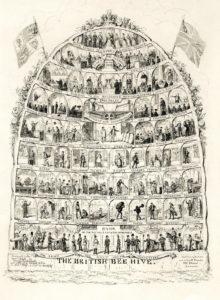
Roger Riderhood’s characterisation in Our Mutual Friend stands in stark contrast to the concept of a gentleman, ‘one of the most important of Victorian notions’ as Robin Gilmour (1981) described it in his book The Idea of the Gentleman in the Victorian Novel. In the Victorian period, the concept of a gentleman, which fascinated Dickens, was connected to notions of virtue, and ‘gentle’ manners and behavior (Gilmour, 1981). It was also connected to class, mainly the middle and upper classes, and social mobility as birth was not the sole criterion that made a gentleman. The industrial revolution enabled regular people to amass fortunes, many of whom sought to fit in by acquiring the appropriate gentlemanly behavior (Hughes, 2014). George Cruikshank’s ‘The British Beehive’ engraving successfully captures the class structure of Victorian England, ranking professions by their importance (see Figure 7). It places manual, sweat-inducing labor at the bottom.
Using the Only in subsets option, I was able to know that 11 of the occurrences of the term in Our Mutual Friend are in the quotes, whereby in 10 instances Riderhood refers to himself, in both the first-person pronoun (my brow) and third-person pronoun (his brow) (see Figure 7). As such, in Dickens’s Our Mutual Friend, the phrase is used, not without irony, to create a portrait of an unscrupulous, un-gentlemanly man.

Conclusion
The good news is that characters do sweat in nineteenth-century fiction. The better news is that their bodily sweating is inexistent and thus odorless, a relief to many readers given the reduced access to running water during the period. As my analysis has shown, references to sweat in nineteenth-century works far from capture the materiality of sweat. They are largely metaphorical. In fact, references to sweat in both 19C and DNov denote characters’ anxieties and serve to criticize the upper classes, all while contributing to the characterisation of Roger Riderhood in Our Mutual Friend. The way in which Gaskell and Dickens depict sweat reveals the class tensions that divided Victorian Britain and its different classes. Using CLiC thus enabled me to answer my questions and discover the symbolic significance of sweat and the contested role it played in the larger cultural consciousness of the Victorians.
References
- ‘Chartists’. (n.d.). The National Archives. Retrieved June 22, 2022 from https://www.nationalarchives.gov.uk/education/politics/g7/#:~:text=Chartism%20was%20a%20working%20class,main%20aims%20of%20the%20movement
- Enelow, S. (2019). Sweating Tennessee Williams: Working actors in A Streetcar Named Desire and Portrait of a Madonna. Modern Drama, 62 (2), 129-148.
- Goodman, R. (2014). How to be a Victorian: A Dawn-to-dusk Guide to Victorian Life. WW Norton & Company.
- Gilmour, R. (2016). The idea of the gentleman in the Victorian novel. Routledge.
- Hughes, K. (2014). The middle classes: Etiquette and upward mobility. British Library. Retrieved June 24, 2022 from https://www.bl.uk/romantics-and-victorians/articles/the-middle-classes-etiquette-and-upward-mobility
- Mahlberg, M., Stockwell, P., Wiegand, V., & Lentin, J. (2020). CLiC 2.1. Corpus Linguistics in Context, available at: clic.bham.ac.uk
- Mahlberg, M., & Wiegand, V. (2018). Corpus stylistics, norms and comparisons: Studying speech in Great Expectations. In R. Page, B. Busse, & N. Nørgaard (Eds.), Rethinking Language, Text and Context: Interdisciplinary Research in Stylistics in Honour of Michael Toolan (pp. 123–143). Routledge.
- New International Version (2010). Zondervan. (Original work published 1973).
- Pinchbeck, I. (2013). Women workers and the industrial revolution 1750–1850. Routledge.
- Sinclair, J. (1991). Corpus, concordance, collocation. Oxford University Press.
- Stubbs, M. (2009). Memorial article: John Sinclair (1933–2007) the search for units of meaning: Sinclair on empirical semantics. Applied linguistics, 30 (1), 115-137. https://doi.org/10.1093/applin/amn052
Please cite this post as follows: Sfeir, M. (2022) ‘By the Sweat of their Brows’ or How Characters (Don’t) Sweat in Nineteenth-Century Fiction [Blog post]. CLiC Fiction Blog, University of Birmingham. Retrieved from [https://blog.bham.ac.uk/clic-dickens/2022/06/24/sweat19thc/]

Join the discussion
0 people are already talking about this, why not let us know what you think?